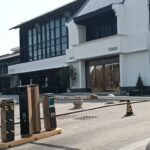Nanjing People’s Hall, formerly known as the Assembly Hall, was completed on May 5th, 1936. In September 1935, Kong Xiangxi and other committee members proposed the construction of an Assembly Hall in the capital. The architectural plan and all equipment were designed to be suitable for a modern theater form. The architectural facade employed the common plinth, body, and capital three-part division method of modern architecture, but the exterior, window grilles, canopies, and door panels were all simplified with Chinese patterns. The interior structure is rational, and the acoustics are excellent. Facing the street are offices, flanked by two-story lounges, with a stage that protrudes in a semi-circular arc, and a crescent-shaped orchestra pit. The hall is fully equipped with automatic voting machines and translation devices, and has over 3,000 seats, all of which are velvet spring chairs. After the founding of the People’s Republic of China, the Assembly Hall was renamed the People’s Hall and has been valued and protected by the government. Directly managed by the Nanjing Municipal People’s Government, the People’s Hall is now an important venue in Jiangsu Province and Nanjing for holding significant meetings, celebrating events, and hosting artistic performances. It has also become an ideal place for domestic and international guests to engage in trade, tourism, and various social activities, including conferences and other gatherings. The opening hours and business status are subject to the daily schedule.
Nanjing People’s Hall
Nanjing People’s Hall, formerly known as the Assembly Hall, was completed on May 5th, 1936. In[...]









